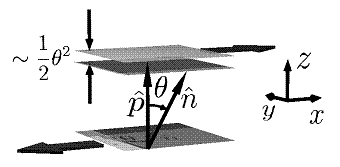Research - Hydrodynamics
Liquid crystals under shear
In contrast to standard smectic-A hydrodynamics where shear in the parallel orientation has no effect on the layers, this destabilizing effect comes out naturally from our extended smectic-A hydrodynamics. The argumentation goes along the following lines. The shear field exerts a torque on the director that must be balanced by the coupling to the layer normal. In the limit of small angles, balancing these torques leads, in the steady state, to a shear-induced director tilt proportional to the shear rate. The preferred thickness of a smectic layer is directly connected to the projection of the averaged molecular axes on the layer normal, or, in terms of our model, the thickness is proportional to the projection of the director on the layer normal. If the director is tilted, this projection is shorter. This decrease of the projection is equivalent to an effective dilation, because the actual layer thickness is larger than the preferred layer thickness. Similar to the case of low molecular weight smectic-A liquid crystals under a dilative strain, this effective dilation leads to an undulation instability.
 |
 |
| Figure 1: Tilt of the director in a smectic layer. | Figure 2: Undulation instability above the threshold value for the applied shear. |
- Soddemann, T., Auernhammer, G. K., Guo, H. X., Dünweg, B., Kremer, K.;
Shear-induced buckling of smectic-A: MD simulations vs. analytical theory;
Eur. Phys. J. E 13 (2004), 141 - 151. - Auernhammer, G. K., Brand, H. R., and Pleiner, H.;
Shear-induced instabilities in layered liquids;
Phys. Rev. E 66 (2002), 061707; Inconsistencies in one equation and one figure are corrected in Phys. Rev. E 71 (2005), 049901(E). - Auernhammer, G. K., Brand, H. R., and Pleiner, H.;
The undulation instability in layered systems under shear flow - a simple model;
Rheol. Acta 39 (2000), 215 - 222.

